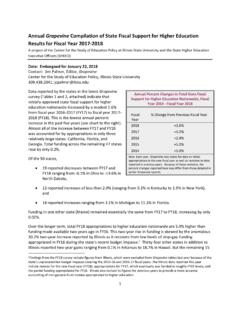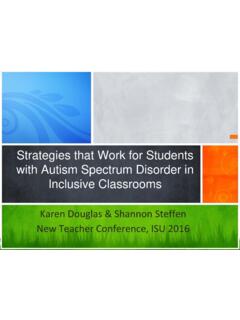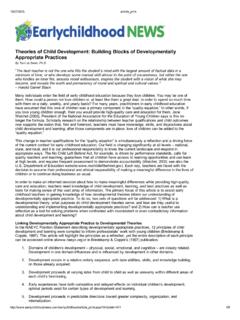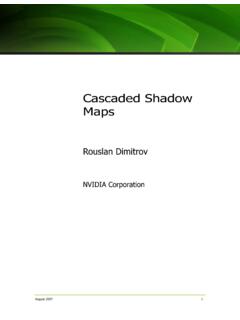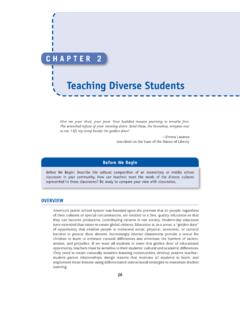Transcription of Teaching Vocabulary Across the Curriculum
1 Learning Vocabulary . This research clearly indicates that enlargement of Vocabulary has always been and continues to be an important goal in literacy and learning (National Institute of Child Health and Human Development, 2004). Educators have long recognized the importance of Vocabulary development. In the early 20th century, John Dewey (1910) stated that Vocabulary is critically important because a word is an instrument for thinking about the meanings which it expresses. Since then, there has been an ebb and flow of concern for Vocabulary (Manzo, Manzo, & Thomas, 2006, p. 612; see also Blachowicz & Fisher, 2000). At times, interest in Vocabulary has been high and intense, and at other times low and neglected, alternating back and forth over time (Berne & Blachowicz, 2008).Research on Vocabulary growth and developmentVocabulary has long been an important topic in middle grades education, but today it could be considered a hot topic (Cassidy & Cassidy, 2003/2004).
2 The National Assessment Governing Board, for example, has added a separate Vocabulary component to gauge student achievement in reading nationwide (Manzo, 2004). This Learning Vocabulary is an important instructional aim for teachers in all content areas in middle grades schools (Harmon, Wood, & Kiser, 2009). Recent research, however, indicates that Vocabulary instruction may be problematic because many teachers are not confident about best practice in Vocabulary instruction and at times don t know where to begin to form an instructional emphasis on word learning (Berne & Blachowicz, 2008, p. 315).In this article, I summarize important research on Vocabulary growth and development and share effective instructional strategies that middle school teachers can use to teach Vocabulary Across the content areas. My hope is that teachers will use these strategies to help students become verbophiles people who enjoy word study and become language enthusiasts, lovers of words, appreciative readers, and word-conscious writers (Mountain, 2002, p.)
3 62).The importance of vocabularyVocabulary can be defined as the words we must know to communicate effectively: words in speaking (expressive Vocabulary ) and words in listening (receptive Vocabulary ) (Neuman & Dwyer, 2009, p. 385). An extensive body of research exists on Teaching and This article reflects the following This We Believe characteristics: Meaningful Learning Challenging Curriculum Multiple Learning ApproachesTeaching Vocabulary Across the CurriculumWilliam P. Bintz44 Middle School Journal March 2011 45focus is in response to recent research highlighting a decline in the Vocabulary levels of college-bound 18-year-olds in recent years (Manzo, Manzo, & Thomas, 2006). This section is a summary of findings from research on Vocabulary growth and development organized around four questions: When does learning Vocabulary start?
4 What does learning Vocabulary mean? How is Vocabulary learned? What is the relationship between Vocabulary growth and reading comprehension? These were selected because they represent fundamental and frequently asked questions about Vocabulary , and these questions have been the focus for an extensive body of research that has produced key findings about Teaching and learning does learning Vocabulary start?One important finding from research suggests that Vocabulary learning never stops (Smith, 1998); it is a natural and lifelong phenomenon. Vocabulary learning is a continual process of encountering new words in meaningful and comprehensible contexts (Harmon, et al. 2009). Consider how young children initially encounter printed text in their surrounding environments. When they walk through supermarket aisles, they can often recognize the name of their favorite box of cereal; or while riding in the family car, they can identify a McDonald s restaurant or a Toys-R-Us sign.
5 Children do this easily, routinely, and usually without parents or other adults explicitly drawing their attention to print. In short, throughout the life span, people develop Vocabulary effectively and almost effortlessly as long as they see words in meaningful addition, individuals learn new words at an amazing rate. During early childhood, children learn Vocabulary at the rate of approximately 2,000 to 4,000 words per year (Brabham & Villaume, 2002; Nagy, Anderson, & Herman, 1987), or an average rate of seven words per day (Anderson & Nagy, 1991; Beck & McKeown, 1991). Amazingly, individuals learn new words at this rate without conspicuous effort or organized instruction and without any forgetting (Smith, 1998, p. 14). Ruddell and Shearer (2002) estimated that, in school, children will encounter in excess of 100,000 words in their reading. Students vocabularies may increase by 3,000 to 5,000 words per year by reading, resulting in a reading Vocabulary of nearly 25,000 words by the eighth grade and over 50,000 by the end of high school (Graves, 2000).
6 Once again, whether in school or out of school, the key to learning words at this amazing rate is that individuals experience words in comprehensible and meaningful contexts (Allen, 1999).What does learning Vocabulary mean? Learning Vocabulary is fundamentally about learning definition of words. Many teachers believe that defining words before reading a text is an effective instructional technique to support Vocabulary growth and enhance reading comprehension; however, research indicates otherwise. For example, the popular practice of requiring students to find definitions of words and write those words in sentences before reading appears to have little apparent impact on their word knowledge and language use, and has not improved student comprehension of texts that contain those words (Kameenui, 1991). Similarly, Stahl and Fairbanks (1986) found that instructional methods that provide only definitional information about each word to be learned or that involve multiple repetitions of definitional information about a target word do not appear to have reliable effects on reading comprehension.
7 Allen (1999) identifies three reasons why strategies that focus on word definitions are not effective: (1) a word can have multiple definitions and meanings depending on the geographic location in which a person lives, (2) a word can have a definition that may not be correct in a particular context, and (3) definitions of words often lack adequate information for students to use them correctly. These findings suggest that learning Vocabulary is more complex than simply memorizing definitions of words; rather, it involves seeing, hearing, and using words in meaningful contexts (Daniels & Zemelman, 2004, p. 13). Strategies that focus on word recognition and word use in meaningful contexts are most likely to positively affect Vocabulary Middle School Journal March 2011 45 Vocabulary learning is a continual process of encountering new words in meaningful and comprehensible contexts (Harmon et al.)
8 , 2009). How is Vocabulary learned? While some Vocabulary learning occurs in school, it is not just a school-based phenomenon. Many children begin formal schooling with rich vocabularies but no formal Vocabulary instruction (Brabham & Villaume, 2002, p. 264), and while they are in school they may continue to learn Vocabulary without much direct and explicit help from teachers (Carey, 1978). For the most part, Vocabulary growth in school occurs informally and incidentally rather than formally and intentionally (Nagy, Perman, & Anderson, 1985). Students learn Vocabulary best in classrooms in which teachers read to them and highlight important and interesting words. In these classrooms, students regularly read independently and in groups and they discuss their understandings in literature circles during and after and incidental Vocabulary learning is quite efficient and effective.
9 Twenty-five to fifty percent of annual Vocabulary growth can be attributed to incidental learning from meaningful context while reading (Nagy et al., 1987). Leung (1992) found read-alouds seem to be a particularly powerful instructional strategy for supporting incidental Vocabulary growth in the elementary grades. Stahl, Richek, and Vandevier (1991) explored indirect learning of Vocabulary words with sixth graders and found that students were able to learn a significant number of Vocabulary words from reading, discussing their reading, and listening to orally presented passages. Collectively, these findings indicate that Vocabulary growth occurs when we immerse students in words in a variety of ways and get them personally and actively involved in constructing word meanings (Duke & Bennett-Armistead, 2003, p. 182).What is the relationship between learning Vocabulary and reading comprehension?
10 Two of the most important findings related to Vocabulary learning are (1) that reading is the single most important factor in increased word knowledge (Anderson & Nagy, 1991) and (2) that a rich Vocabulary increases comprehension and learning (Manzo, Manzo, & Thomas, 2006; Robb, 2009). In other words, students develop extensive vocabularies not by completing worksheets, memorizing word lists, or using a dictionary or glossary to define unknown words but by the act of reading (Weir, 1991). Nist and Olejnik (1995) investigated the impact of dictionary use on Vocabulary growth and found that definitions in the dictionary were not very helpful to students and that they did not use them very productively, if at all. Allen (1999) and Robbins and Ehri (1994) contended that Vocabulary growth is the result of the extensive amount of reading that occurs in a balanced reading program that includes read-alouds and think-alouds; shared, guided, and independent reading experiences; and fictional and informational book readings that focus children s attention on meanings of unfamiliar words in context.





